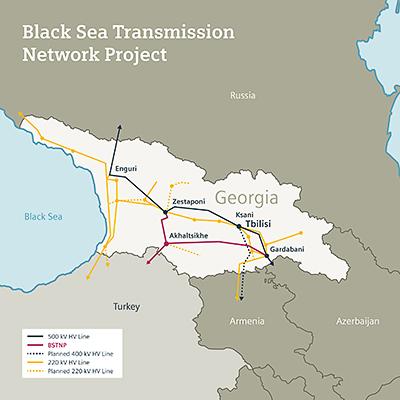Georgia exports renewable power to Turkey

Georgia has an abundance of renewable power sources, such as hydro and wind. Georgia's grid network was not designed as a network for an independent state, as it was part of the power supply in the Caucasus that was linked to the Soviet republics. The challenge is to break down existing barriers across the boarders, connect different power supply networks of varying technical parameters (frequency, phasing), and stabilize power supply, while enabling the export of excessive power.
The Georgia-Black Sea Transmission Network project began in 2010 with support from the European Investment Bank, the European Bank for Reconstruction and Development, the German KfW Group, and the Development Bank of Austria. The ambitious project completed with a ceremony on December 12, 2013 with the minister of Georgia and the minister of Turkey in attendance, at the new substation in Akhaltsikhe, Georgia.
Siemens Energy completed two back-to-back high-voltage direct current (HVDC) links at the Akhaltsikhe substation in southern Georgia close to the Turkish border, for Energotrans Ltd. The new back-to-back HVDC links feed a 400-kV overhead transmission line that connects to the Turkish 400-kV grid at the border. Each link transmits 350 megawatts (MW) of eco-friendly electric power, which is crucial for Turkey's growing power demand.
The three-phase alternating current of the one network is converted in the new converter substation into direct current and transmitted directly via a DC link to the inverter station. There, the direct current is converted back into three-phase current with simultaneous adjustment to the parameters of the network into which it is to be fed. This enables seamless interconnection of the two networks.
The Georgian network is based on a 500-kV system. The Georgia HVDC station converts power from 500- to 400-kV and back. The station operates on two back-to-back links, each line of which is able to transmit 350 megawatts of power. The line to Turkey is 151 kilometers long, ending at Borchkha substation in Turkey.
The HVDC back-to-back links provide protection against cascading grid disturbances because it acts like an automatic firewall, which can control stops and restarts of the transport of electric power.
Fuel Flexibility in Heavy-Duty Gas Turbines: A Key Driver for Energy Transition
March 13th 2025From Hydrogen to HVO, Mr. Federico Bonzani, Chief Technology Officer of Ansaldo Energia, describes the fuel flexibility state-of-the-art solutions of the Company to meet the actual and future needs of power generation industry.